
Morehouse Parish guide says duck-hunting success boils down to location, keeping your blind in tip-top shape and knowing when and how to call.
A good decoy spread and good duck calling that make the big mallards want to come to Momma are great. But when you match them up with a “Wink,” it’s time to get the lanyard out and start counting out your limit.
A Wink?
Well, not just any Wink, but veteran duck-hunting guide Johnny Wink of Jones, who owns and is head guide for MegaDucks Duck Club in Morehouse Parish.
Wink has been putting folks on limits of ducks for 45 years — and he did it the hard way.
“When I was in the 10th grade in West Monroe, the good Lord put me up here, and I’ve been here ever since,” he said.
Wink was an all-state high-school baseball player who played in college, but his passion was always duck hunting. When he was barely old enough to drive, he made a deal to hunt in a blind in the middle of a field next to the world-famous Schenley Duck Club, the first commercial duck operation in his home parish. In those days, Schenley was an overnight destination for the rich and famous, who hunted out of a luxurious camp and the best blinds money could buy. Wink hunted out of a hand-made cane blind, but he killed more ducks than some of their guides.
The reason nobody wanted the spot he was hunting was that you had to wade across more than a mile of flooded, muddy fields to get to the makeshift blind.
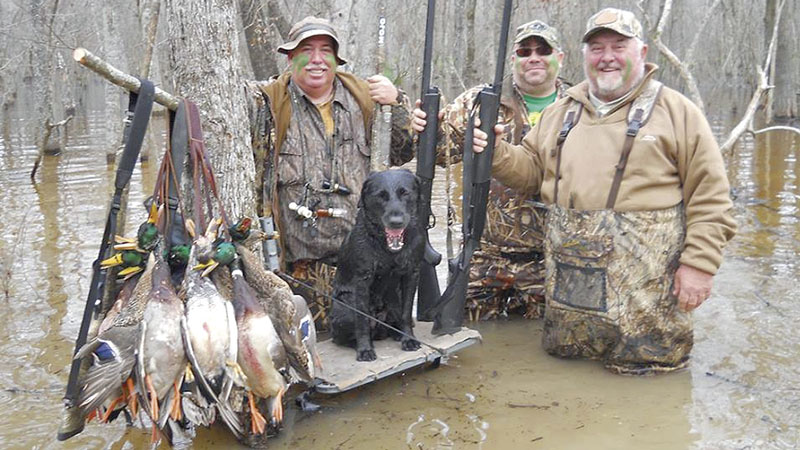
Back in the day
Wink fondly recalls those early days. He would load up a dozen old, rubber, fold-up Deek’s decoys and stuff them in his pockets. He would put some drinking water, snacks and his shells in an old croaker sack and head out with it over one shoulder and his gun on the other across the field. It was a physically challenging trek.
“We began to kill so many ducks that eventually, somebody with a lot more money than I could ever come up with, leased it out from under me,” Wink said. “Soon, though, they weren’t killing any ducks but were paying a fortune on a long-term lease.
One of hundreds of memories from those days sticks out in his mind more than others. One day as he came out, he was walking down the levee road, and two six-wheelers from the club stopped, asking if he had killed any ducks. He showed him his sack full of ducks, and the hunters in the back seat, a man and woman, got out and said, “Man, he killed a lot more than we did.” He found out later they were Lee Majors and Farrah Fawcett — the Six Million Dollar Man and one of Charlie’s Angels.
A valuable lesson
Those days when he lost his best blind taught Wink one of his most-valuable lessons, something that he’d been told years before by Phil Robertson, the legendary Duck Commander.
“Wink, it isn’t the blind that makes the man,” Robertson said. “It’s the man that makes the blind.”
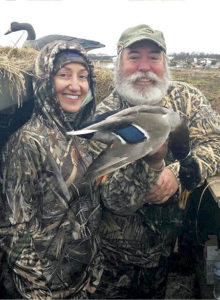
That advice has served him well over the years, and he’s glad to pass that and other tips on to hunters, whether they are going on a guided trip or to their own spot. In those days, Wink worked with Robertson, making and selling his decoys all across the southeast. Wink’s blinds are featured in many of the early Duck Commander videos.
Wink points out that his main objective is the same objective that any duck hunter should have. First and foremost, be safe. No duck is worth somebody getting hurt. Whether you shoot ducks or not, it’s important that everybody go home just like they came.
Making sure everyone has a good time is important, too.
“Whether a man comes across the ditch or across the country to go duck hunting with you, you have to remember, it’s an honor that he is taking time away from his family and taking dollars out of his pocket to go hunting with you,” he said. “I remind myself all the time and make sure my guides know that we need to treat every day in the blind like opening day. If we aren’t fired up, we can’t expect others to be.”
Wink breaks his near 50 years of duck-hunting knowledge down into three pieces of advice for more successful hunts.
Location, location, location
“First, it starts with location,” he said. “If you are in a place that’s just marginally where the ducks are, things aren’t going to be easy. You need to be in the general vicinity of where ducks are flying. It doesn’t have to be in the best spot, but ducks will come only so far out of their way when they are migrating.”
Ducks usually feed in the fields and go to deeper-water areas to roost at night, places where they feel more safe from predators. Spend some time patterning ducks and knowing their flyways is important. You might find a pond or river that has a few wood ducks and occasionally some big ducks come in, but you will be better off areas that ducks regularly fly over.
Keep your blind in shape
The second tip is to always keep working on your blind. Get it brushed early, and don’t let it go down as the season progresses.
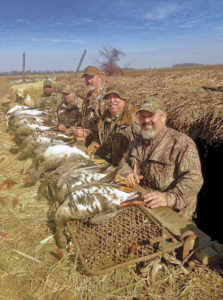
“I’ll go back to what Phil said earlier,” Wink said. “You make the blind. I’m all in on putting big pit blinds in the levee, but we will go to the woods if the ducks are only going there. But the key to our season is the pit blinds. Make sure you brush every inch of your blind and put out enough decoys.
“Don’t let it go down during the season. Wind, rain, the dog running across it, people crawling in and out — it all takes a toll. Don’t leave half-floating decoys out in the spread. Just keep your blind and decoy spread in opening day condition all year-long.”
Calling: make or break
The third most important thing is duck calling. Once everything else is in place, this can be the make it or break it factor.
“I can’t stress enough that knowing when to call and how much to call is critical to duck hunting,” he said. “You have to decide, ‘Do I want to impress the other hunters with my calling or do I want to impress the ducks?’ Here’s what I mean. If I’m sitting there on a bluebird day and a group of mallards heads right for the decoys, I don’t need to do a thing. If they are looking at the mojo and cupping up to come in, I don’t call. If I do, I break their focus, and I get them looking at that hole in the ground. Don’t do that.
“When we have flight ducks, I will call enough to get their attention, but then I’ll back off. Now, if they circle around and look like they are losing interest, I’ll call lightly and let them know it’s safe to come in. If I start to lose them, then I’ll really call and beg. Blasting a call all the time is one of the worst things you can do.”
How much does it cost?
Booking a guided duck-hunting trip costs anywhere between $300 to $1,000 a day, per person, depending on where you are and the amenities that might be added.
At MegaDucks, Johnny Wink (318-669-4757 or www.johnnywink.com) keeps it simple. It’s $350 a day per person, and if you book a party of four or more, you get to hunt and have exclusive use of the MegaDucks lodge and party barn. That includes a guide and a retriever.
“That’s what most people like to do, because you don’t want to be hunting or staying in a camp with people you don’t know,” Wink said. “Half of the fun of the duck hunt is sitting around the fire pit telling stories, cooking and just sharing time with friends and family.”
Twenty-four days of early speckled belly goose hunting are offered in Louisiana as well. During this “warm-up” period for duck season, Wink charges $200 a head.
Duck, duck, goose!
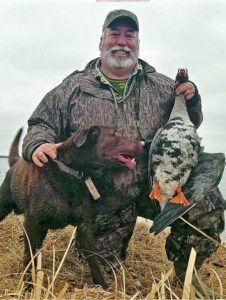
When people book a waterfowl guide, there’s usually one thing on their mind; ducks. And most people, according to guide Johnny Wink, want to shoot mallards.
But hunting the rice fields gives hunters a bonus that they often enjoy as much or more as shooting mallards.
“We are blessed with some unbelievable goose hunting here, and MegaDucks is right in the middle of the best action in the state,” Wink said. “We are right next to the area they call ‘Eagles Nest’ that roosts 90% of the specklebellies. When they take off in the morning, they come right over us.”
Wink pumps up water at his blinds a month before most hunters and gets them ready for the goose hunt. Over the years, he almost fills up every day with trips and books all the weekends.
“It’s a great warm-up for duck season,” he said. “The great thing is that it’s an opportunity to bring the kids and get in some good shooting. Specks break off and head into the decoys just like ducks. And there are plenty of them. It brings a lot of money into the economy in our area, too. Lord knows we need that.”
Wink’s retirement fund: A 401(Miss) Kay
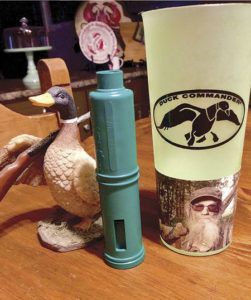
Building a duck-hunting guide service from scratch and not being a large landowner, Johnny Wink making a living every year has to depend on the hunts he makes. He knows how blessed he is to call a duck blind his office, but he also knows that after 45 years of doing it, it hasn’t made him rich.
But along the way, he has come across some “investment opportunities” that he will depend on when he finally retires.
“You know the most sought-after duck in the world?” he asked. “It’s the mallard — and it’s the mallard drake. Do you know who patented the first-ever drake mallard call? They sound totally different than the hen calls we use duck hunting. There have been some made way back in the early 1900s, but the first one that was patented was made by hand by Phil Robertson and his wife, Kay. You know who owns that one? Me. They gave it to me. It’s in my vault.
“I call it my 401(Miss) Kay,” he says. “I don’t want to part with it, but the way duck-call collectors pay megabucks for special calls, I have it if I need it.”


